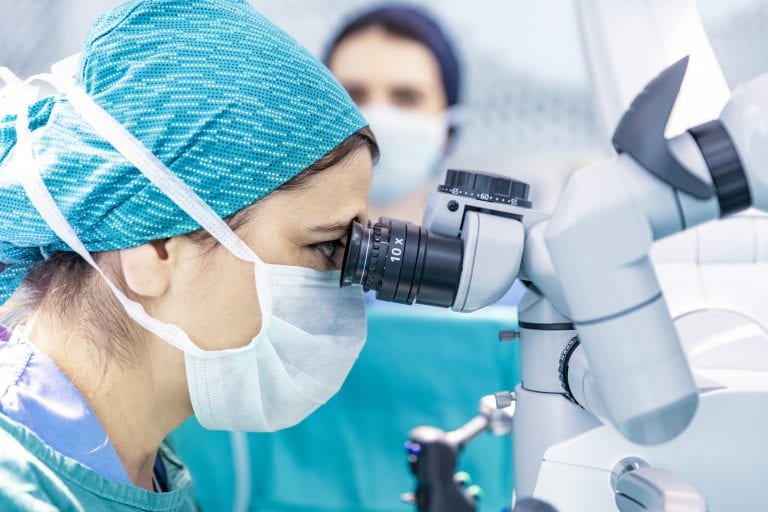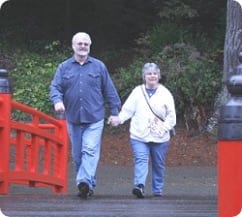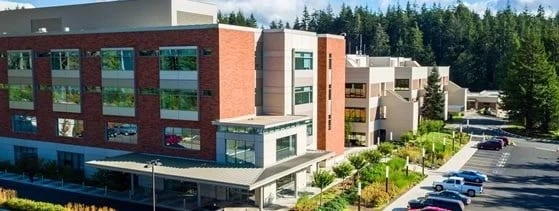A Robot That Can Help You Heal
Bay Area Hospital’s da Vinci Si Robotic Surgery System puts your surgeon’s hands on the controls of a state-of-the-art robotic platform. This exciting technology provides surgeons with a minimally invasive alternative to traditional “open” surgery or conventional laparoscopy.
As a result, you may be able to recover faster than you otherwise could after major surgery. That means returning to your normal life sooner.

How Robotic Surgery Works
Unlike robots in the movies, the da Vinci Si Surgical System can’t walk, talk, or transform itself into a car. Even though it’s commonly called a “robot,” the da Vinci system can’t do anything on its own. Instead, the robot expands your surgeon’s capabilities by offering a state-of-the-art, minimally invasive option for major surgery.
Robotic technology translates the doctor’s hand movements into precise micro-movements of the da Vinci instruments. With da Vinci, your surgeon uses tiny incisions to insert miniaturized instruments and a high-definition 3D camera. The da Vinci console gives your surgeon a magnified, high-resolution, 3D image of the surgical site inside your body.
Why Robotic Surgery?
Potential benefits of robotic-assisted surgery include:
- Shorter hospital stay
- Less blood loss
- Less pain
- Faster recovery
- Smaller incisions for minimal scarring
Types of Surgeries
The range of surgical procedures performed with robotic assistance continues to grow. Many of the procedures being performed robotically at Bay Area Hospital fall into these categories:
- General surgery
- Gynecological surgery
- Hysterectomy (removal of the uterus)
- Removal of ovarian cysts
- Sacral colpopexy (correction of a vaginal prolapse)
- Diagnosis and treatment of endometriosis (a disorder in which the tissue lining the uterus grows outside the uterus)
- Urological surgery
- Prostatectomy (removing all or part of the prostate gland)
- Nephrectomy (removing all or part of a kidney)
- Pyeloplasty (correcting a blockage between a kidney and the ureter, the tube that takes urine to the bladder)
- Cystectomy (removing all of the bladder, with bladder substitution)
Firefly Fluorescence Imaging
For some robotic-assisted procedures, surgeons at Bay Area Hospital employ Firefly Fluorescence Imaging to improve visibility of the surgical area. Firefly’s imaging capability provides real-time, image-guided identification of key anatomical landmarks for precise surgical maneuverability.
The Firefly system uses a special video camera and glowing dye to let surgeons view blood flowing in vessels and tissue during minimally invasive surgical procedures. Viewed with the Firefly camera, blood appears green, and tissue without blood flow appears gray.
Surgeons at Bay Area Hospital were the first in Oregon to use Firefly.

Our Patients' Stories
Living with an inguinal hernia was uncomfortable and unpleasant for 62-year-old Joseph Sicheneder of Coos Bay. Robotic surgery to fix it was remarkably easy.
“It all went as good as could be imagined.”
In November 2013, surgeon Steven Tersigni, MD, used the da Vinci Si Surgical System to make four tiny incisions in Sicheneder’s abdomen.
“I’m taking his word that he used it,” Sichender joked, “because I slept through the whole thing.”
Sicheneder went home the same day. A month later, the longtime longshoreman pronounced himself completely healed.
“I’m able to get out and walk around, and sit comfortably,” he said. He was ready to go back to work – but he didn’t. Instead, he chose a well-earned retirement.

“I would have liked to watch.”
Arleta Vincent, 71, underwent a surgery to correct two stomach conditions: hiatal hernia and gastrointestinal reflux. Surgeon Steven Tersigni, MD, wrapped the top part of her stomach around her esophagus and stitched it into place.
“I feel like my surgery went really, really well,” Vincent said. “My only regret is that I didn’t get to see it. I would have liked to watch.”
The robot had been in use just a couple of months when Vincent underwent surgery in November 2013, but she wasn’t at all concerned about a comparatively new technique. Though the robot was new in town, she knew and trusted her human surgeon.
“I figured if Dr. Tersigni recommended it, it was good enough for me,” she said. “I was just willing to take his advice.”















